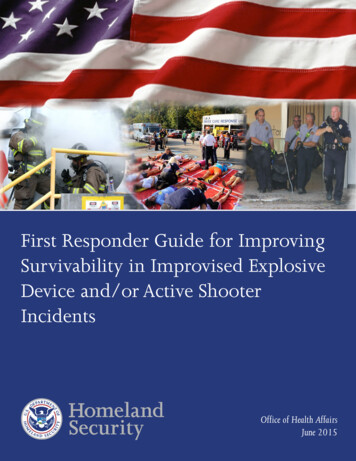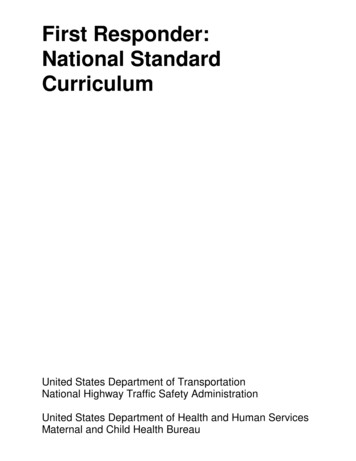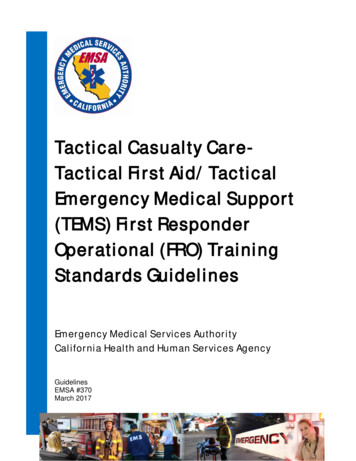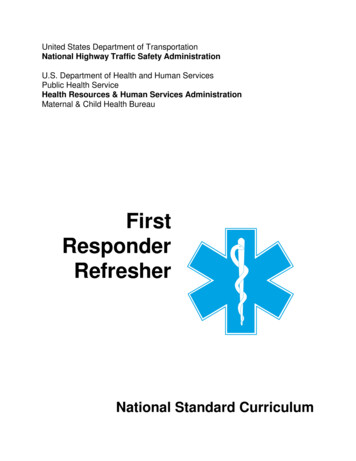
Transcription
First Responder Guide for ImprovingSurvivability in Improvised ExplosiveDevice and/or Active ShooterIncidentsOffice of Health AffairsJune 2015
Table of ContentsList of Contributors4Executive Summary6Purpose8Background9A. Defining First Responders9B. Defining the Threat9C. Military Lessons Learned and Civilian Adaptation10Tactical Combat Casualty Care10Tactical Emergency Casualty Care10En Route Care11Hospital-Based Measures12D. Improvised Explosive Device Incidents12Morbidity and Mortality Prevention12Published Civilian Experience13E. Active Shooter Incidents14Morbidity and Mortality Prevention14Published Civilian Experience14F. Hemorrhage Control15Control of External Hemorrhage in the Prehospital Setting15G. Protective Equipment17First Responders17Army Testing of Personal Protective Equipment18H. Response and Incident Management18Responder Guidelines21A. Hemorrhage Control212
B. Protective Equipment21C. Response and Incident Management22Summary24Threat-Based Scenarios25Scenario 1: Large-Scale Terrorist/Insurgency Attack26Scenario 2: Medium-Scale Terrorist/Insurgency Attack30Scenario 3: Medium-Scale Terrorist/Insurgency Attack34Scenario 4: Small Scale Terrorist/Insurgency Attack38Scenario 5: Involuntary Suicide Bomber42Scenario 6: Discovery/Recovery of Homemade Explosives (Not an Attack)46Scenario 7: Active Shooter with Access Denial to First Responders48Scenario 8: Active Shooter in a Public Commercial Facility52Scenario 9: Active Shooter in an Open, Outdoor, Unbounded Location56Scenario 10: Active Shooter in a Public Sports Complex60Acronyms Used in this Document64Background Documents (key sources highlighted in bold)65Endnote References Cited in the Guidance683
List of ContributorsCenters for Disease Control and Prevention, National Institute for Occupational Safety and HealthCenters for Disease Control and Prevention, Office of Infectious DiseasesCenters for Disease Control and Prevention, Office of Public Health Preparedness and ResponseNational Security Staff, Legal Affairs DirectorateNational Security Staff, Resilience DirectorateOffice of Personnel ManagementU.S. Agency for International DevelopmentU.S. Department of Health & Human Services, National Institutes of HealthU.S. Department of Health & Human Services, Office of the General CounselU.S. Department of Health & Human Services, Food and Drug AdministrationU.S. Department of Health & Human Services, Centers for Medicare & Medicaid ServicesU.S. Department of Health & Human Services, Office of the Assistant Secretary for Preparedness and ResponseU.S. Department of Agriculture, Office of the General CounselU.S. Department of Defense, Army Research Laboratory Survivability/Lethality Analysis DirectorateU.S. Department of Defense, Defense Threat Reduction Agency, J9 Research & DevelopmentU.S. Department of Defense, Joint Chiefs of Staff, J4 Logistics DirectorateU.S. Department of Defense, Joint Chiefs of Staff, J5 Strategic Plans and Policy DirectorateU.S. Department of Defense, Office of the General CounselU.S. Department of Defense, Office of the Secretary of Defense, Office of the Assistant Secretary of Defense forHealth AffairsU.S. Department of Defense, Office of the Secretary of Defense, Office of the Assistant Secretary of Defense forHomeland Defense and Americas’ Security AffairsU.S. Department of Defense, Office of the Secretary of Defense, Director of OSD Cost Assessment and ProgramEvaluationU.S. Department of Defense, Office of the Secretary of Defense, Office of the Under Secretary of Defense forPolicy4
U.S. Department of Homeland Security, Customs and Border ProtectionU.S. Department of Homeland Security, Federal Emergency Management AgencyU.S. Department of Homeland Security, Office of Health AffairsU.S. Department of Homeland Security, National Protection and Programs DirectorateU.S. Department of Homeland Security, Office of PolicyU.S. Department of Homeland Security, U.S. Coast GuardU.S. Department of Homeland Security, U.S. Secret ServiceU.S. Department of Justice, Office of Justice ProgramsU.S. Department of Justice, Civil DivisionU.S. Department of Justice, Federal Bureau of InvestigationU.S. Department of Justice, National Security DivisionU.S. Department of Justice, Office of Foreign LitigationU.S. Department of Labor, Occupational Safety & Health AdministrationU.S. Department of StateU.S. Department of Transportation, National Highway Traffic Safety Administration, Office of Emergency Medical ServicesU.S. Department of Transportation, Office of the Under Secretary for PolicyU.S. Department of Veterans Affairs, Veterans Health Administration Office of Emergency Management5
Executive SummaryRecent improvised explosive device (IED) and active shooter incidents reveal that some traditional practices offirst responders need to be realigned and enhanced to improve survivability of victims and the safety of firstresponders caring for them. This Federal, multi-disciplinary first responder guidance translates evidence-basedresponse strategies from the U.S. military’s vast experience in responding to and managing casualties from IEDand/or active shooter incidents and from its significant investment in combat casualty care research into thecivilian first responder environment. Additionally, civilian best practices and lessons learned from similarincidents, both in the United States and abroad, are incorporated into this guidance. Recommendationsdeveloped in this paper fall into three general categories: hemorrhage control, protective equipment (whichincludes, but is not limited to, ballistic vests, helmets, and eyewear), and response and incident management.Hemorrhage Control1. First responders should incorporate tourniquets and hemostatic agents as part of treatment for severebleeding (if allowed by protocol). Tourniquets and hemostatic agents have been demonstrated to bequick and effective methods for preventing exsanguination from extremity wounds (tourniquets) andother severe external bleeding (hemostatic agents).2. First responders should develop and adopt evidence-based standardized training that addresses thebasic, civilianized tenets of Tactical Combat Casualty Care (TCCC). Training should be conductedin conjunction with fire, emergency medical services (EMS), and medical community personnel toimprove interoperability during IED and/or active shooter incidents.Protective Equipment1. First responders should develop inter-domain (EMS, fire, and law enforcement) Tactics, Techniques,and Procedures (TTPs)—including use of ballistic vests, better situational awareness, and application ofconcealment and cover concepts—and train first responders on them.2. As technology improves, first responders should adopt proven protective measures (e.g., body armor)that have been demonstrated to reliably shield personnel from IED fragments and shock waves.3. First responders, when dealing with either IED or active shooter incidents, must remain vigilant andaware of the potential risk posed by secondary IEDs or additional shooters.Response and Incident Management1. Local and state law enforcement and emergency services should institutionalize National IncidentManagement System (NIMS)-based command and control language through plans and exercises andduring ongoing education and training.2. Local and state emergency management, EMS, fire, and law enforcement personnel and receivingmedical facilities should have interoperable radio and communications equipment.3. Local, state and federal partners should consider expansion of Public Safety Answering/Access Point(PSAP) intake procedures to include information gathering vital to the initial response.4. Training to improve first responder triaging precision is essential for dealing with IED and/or activeshooter incidents.5. There should be greater coordination among EMS, fire services, and law enforcement to work moreeffectively during IED and/or active shooter incidents. The dialogue should focus on potentialimprovements or changes to the TTPs which have historically been used during law enforcement6
situations that involve a medical emergency (e.g., EMS waits until law enforcement secures the scenebefore they enter to render emergency care).The recommendations presented—early, aggressive hemorrhage control; use of body armor and a moreintegrated response; and greater first responder interoperability—will help to save lives by mitigating firstresponder risk and by improving the emergent and immediate medical management of casualtiesencountered during IED and/or active shooter incidents.7
PurposeRecent improvised explosive device (IED) and active shooter incidents reveal that some traditional practices offirst responders need to be realigned and enhanced—with an emphasis on early hemorrhage control and a moreintegrated response by first responders (i.e., emergency medical services [EMS], fire, law enforcement, andrescue personnel)—to improve survivability of victims and the safety of first responders caring for them.1 At therequest of first responders and first receivers (e.g., medical technicians, nurses, and physicians) who haveencountered mass casualties from IEDs and/or active shooter incidents, this document was developed toprovide guidance on how to better approach these incidents.Responders should also consider the combination of both IEDs and active shooter incidents in an organized,complex attack (such as the Mumbai attacks in 2008) that requires both treatment and extraction of the injuredfrom a still-hostile environment. The conditions during such tactical assaults in a civilian setting speak to theneed for first responders and first receivers to adopt evidence-based hemorrhage control, risk evaluation, andcasualty management measures in a potentially dangerous environment.As a result of these developments, the Department of Homeland Security, in coordination with the Departmentof Defense (DoD), Department of Health and Human Services, Department of Justice, Department ofTransportation, White House Office of Science and Technology Policy, and the National Security Staff, hasdeveloped recommendations for individuals who provide emergent and immediate medical management ofcasualties resulting from IEDs and/or active shooter incidents. Based on best practices and lessons learned, thisdocument focuses on the medical response to IEDs and/or active shooter incidents with recommendations forhemorrhage control, protective equipment (which includes ballistic vests, helmets, and eyewear), and responseand incident management.8
BackgroundA.Defining First RespondersIn this guidance, the term “first responder” refers to a diverse set of persons who, from the earliest stages ofan incident, are critical to managing and caring for people who are injured by an IED and/or active shooterincident. The term “first responder” does not imply a formal credential, certification, limitation, or capacity.First responders may include bystanders, law enforcement, and EMS and fire personnel. EMS and firepersonnel typically encompass the traditional scopes of practice as identified in the National Highway TrafficSafety Administration's National Scope of Practice Model (2007). Levels of medical credentialing and quantityof resources for EMS and fire personnel can vary greatly depending on the EMS delivery model. Bystanders,who likely will be on scene prior to EMS, fire, or law enforcement arrival, may or may not have some form ofmedical training, and those volunteering at the site of an attack may be poorly equipped and at risk foradditional explosions, ballistic threats, and hazardous environments. In some areas, the jurisdiction involvedmay benefit from volunteer services such as Community Emergency Response Teams (CERTs), the EmergencySystem for Advance Registration of Volunteer Health Professionals, or the Medical Reserve Corps (MRC).These volunteers are organized and trained to provide community support to natural disasters, accidents, andattacks. In the United States, the role of first receivers is frequently associated with“brick and mortar” medical facilities that often do not have the protective equipment necessary to face potentialhostile conditions or hazardous environments.B.Defining the ThreatSingle or multiple IED events targeting civilians and/or first responders represent an ongoing and growingthreat from domestic and foreign individuals or groups. In the United States between 1970 and 2011, excludingthe 9/11 attacks, four of six attacks with more than 50 injuries, and 22 of 45 attacks with more than fiveinjuries, involved IEDs.2 IED “types” likely to cause mass casualties include “leave behind” parcels, backpacks,or luggage placed in crowded environments; “suicide vests” or “suicide belts”; and especially vehicle bombs.Traumatic injuries may result from IEDs in many ways: from penetration or blunt force trauma caused by thefragmentation and high-velocity projection of pieces of its immediate container (e.g., a metal pipe, box, orpressure cooker); from items intentionally added to compound the number of projectiles (e.g., ball bearing, nails,etc.); from incidental fragmentation and projection of material or debris from a larger container or vessel theIED is placed within (e.g., a vehicle trunk or trash bin); by collateral fragmentation and/or projection of materialaffected by blast, such as windows, walls, or other objects in the vicinity; and by blast overpressure itself, withoutany projectiles at all. Where an IED is placed—indoors or out, near or far from other objects—will influence itsblast effects. Understanding the numerous ways in which IEDs can cause injuries and how the environmentplays a role in exacerbating or mitigating their blast effects is critical to increasing survivability whenunexploded IEDs are present or secondary IEDs are suspected. In addition to causing life and limb threateninginjuries, these events generate confusion, uncertainty, and fear at the scene that ripple throughout the receivingmedical system.Active shooter incidents represent a similar, and increasing, threat to responders. Like IED events, activeshooter incidents require extraordinary efforts on the part of first responders. Though these incidents typicallyend within a short period of time, some may involve large, complex locations and require many hours to clearsuspected hazards after the initial event.9
C.Military Lessons Learned and Civilian AdaptationExperience in combat casualty care gained by the U.S. military during the wars in Iraq and Afghanistan,augmented by the DoD’s investment in trauma care and surgical research, has resulted in a vast amount ofknowledge pertaining to the management of explosive injury and gunshot wounds, with a particular focus onlife-threatening external hemorrhage control.Tactical Combat Casualty CareInformation on wounds suffered by U.S. Army soldiers in Vietnam between July 1967 and June 1979 found thatof those killed in action, 9 percent died from extremity hemorrhage, 5 percent died from tensionpneumothorax, and 1 percent died from airway obstruction.3 These findings, that one-sixth of combatcasualties result from three types of wounds that are easily treated in the field, led to the development in the late1990s of Tactical Combat Casualty Care (TCCC)—a set of prehospital trauma care guidelines for battlefield usethat focus on the most common causes of treatable exsanguination deaths in combat.4Tactical Emergency Casualty CareRecognizing how this military experience could apply to civilian high-threat medical operations, an independentgroup of civilian first responders in 2011 founded the Committee for Tactical Emergency Casualty Care(C-TECC)5 to develop guidelines that translate military medical lessons learned from the battlefield to civiliancrisis response. The resulting Tactical Emergency Casualty Care (TECC) guidelines are a set of evidencebased best practice recommendations for casualty management during high-threat civilian tactical and rescueoperations that are based on military TCCC principles but account for differences in the civilian environment,resources allocation, patient population, and scope of practice. It is important to emphasize that C-TECC is anindependent civilian entity and not necessarily endorsed by the DoD. TECC is the civilian evolution of TCCC,written to address the subtle differences in the civilian operational environment.6A collaborative group of public safety organizations—including fire, law enforcement, pre-hospital care,trauma care, and the military—convened in Hartford, Connecticut, in the spring of 2013 to develop consensusregarding strategies to increase survivability in mass-casualty shootings (commonly referred as the HartfordConsensus). The group states that “no one should die from uncontrolled bleeding” and developed the acronymTHREAT to address these situations:Threat suppression,Hemorrhage control,Rapid Extrication to safety,Assessment by medical providers, andTransport to definitive care.7In its “Call to Action,” this group of experts advocates that uninjured or minimally injured victims can actas rescuers; law enforcement should utilize external hemorrhage control as a core skill; EMS, fire, and rescueresponse must be more fully integrated and their traditional role limitations revised; and existing trauma systemsshould be used to optimize seamless care.Concerned international and national first responder associations, such as the International Association ofChiefs of Police, International Association of Fire Fighters, International Association of Fire Chiefs, NationalAssociation of Emergency Medical Technicians, and the National Tactical Officers Associations, haveshown great interest in this topic, and many have published position statements. The fire associations state10
that “common tactics, common communications capabilities and a common lexicon for seamless, effectiveoperations” i are required and “integrated and coordinated planning, policies, training and team buildingprior to the incident will ensure effective and successful response.” ii Additionally, the National TacticalOfficers Association (NTOA) states that there is a need for all police officers to have basic Tactical EmergencyMedical Support (TEMS) medical training in order to potentially save the lives of victims, bystanders, policeofficers, and suspects in the event they are wounded.NTOA has also stated that there is no single model for providing care during law enforcement operations andthat TEMS basic principles should be considered core law enforcement skills relevant to all police operations, asNTOA “supports the efforts of the Committee for Tactical Emergency Casualty Care (C-TECC) and others tofoster the development of standardized taxonomy and evidence based clinical practice guidelines tailored tothe law enforcement mission.” iiiThe following is a list of select TCCC/TECC interventions that have potential applicability in civilian traumacare systems following an IED and/or active shooter event:1. The use of tourniquets to control extremity hemorrhage.2. The use of hemostatic gauze to control bleeding from sites not amenable to tourniquet.3. The use of a nasopharyngeal airway for patients without maxillofacial or neck trauma.4. Positioning of a casualty in a recovery posture if feasible for conscious patients with maxillofacialtrauma and bleeding into the airway.5. Spinal precautions when feasible for patients with blunt but not penetrating trauma.6. Intravenous (IV) access is not routinely required in the initial phase of treatment but can be performedby those with appropriate training and oversight.The following additional interventions may be performed by those with advanced life support (ALS) trainingand capabilities:7. Surgical airway if “sit up and lean forward” posture not possible in those with face/neck trauma.8. Intraosseous (IO) access for medications or fluids when IV not successful or possible IO access is notroutinely required in the initial phase of treatment.9. IV morphine, oral transmucosal fentanyl citrate lozenges, and ketamine for analgesia.Lessons learned from the military’s recent combat experiences, and their civilian C-TECC counterparts, areincorporated within this guidance.En Route CareIt is important to emphasize that emergency medical care activities should not stop as a casualty is evacuated.In fact, the military’s experience demonstrates that continuation or escalation of these measures is critical inIAFF Position Statement: Active Shooter Events. http://www.iaff.org/Comm/PDFs/IAFF Active Shooter Position Statement.pdf.iiIAFC Position Statement: Active Shooter Events. http://www.iafc.org/files/1ASSOC/IAFCPosition ActiveShooterEvents.pdf.iiiTEMS Position Statement. ent/.i11
reducing mortality during prehospital care. While there is a need to understand how these military experiencesin prehospital patient care can be leveraged to decrease morbidity (illness or injury) and mortality (death) in thecivilian setting, the ability to translate the military’s findings related to on-site and en route care to the civiliansetting has not been fully demonstrated.Hospital-Based MeasuresThe military’s combat casualty care research on hospital-based management of patients with severe explosionrelated injuries is documented in a Balad Air Base Report from 20088 and on the Joint Trauma System ClinicalPractice Guidelines website.ivOne particularly successful strategy is damage control resuscitation (DCR), which demonstrated decreasedmortality associated with the use of a blood component-based volume replacement compared to the use ofcrystalloid fluids for patients in shock. DCR is based on the balanced administration of thawed plasma,pRBCs, and platelets in severely injured patients instead of solutions such as normal saline and lactatedringers.9 10 11 12 DCR also includes avoidance of hypothermia and pursuit of other measures to maximizeoxygenation and reduce injurious factors in the blast-injured patient.D.Improvised Explosive Device IncidentsMorbidity and Mortality PreventionThere are three broad concepts related to the prevention or reduction of morbidity and mortality associated withan explosive event:1. Prevention: Avoiding or thwarting the detonation is obviously the best way to avert IED-related injury,suffering, and death. Primary preventive measures, including improvements in preemptive mentalhealth capabilities, an aware public who is able and willing to report suspicious pre-attack behaviors,tactical operations employed to render the device safe, and law enforcement intelligence gathering andthreat-analysis capabilities, are beyond the scope of this paper. Preventing injuries of first respondersand the public is of great importance. Safe distance from suspicious packages aids in preventing injuriesfrom IEDs (see Figure 1).2. Mitigation: This concept refers to actions taken to reduce the impact of an explosive event once anexplosion has occurred, such as use of protective equipment and the placement of physical blastmitigation barriers or windows, and are sometimes referred to as secondary preventive measures. Someof the more sophisticated military protective equipment—including vests with ceramic plates, helmets,and protective undergarments—have been designed for and tested against mechanisms of injuryresulting from explosive devices and ballistic threats. Most of the protective equipment available tocivilian first responders, however, has been designed for protection from ballistic threats and was notdesigned, manufactured, or intended to provide protection from IEDs. It should also be noted that mostprotective equipment is focused on ballistic protection and may have unproven or limited value formitigating fragmentation or blast overpressure, particularly for devices with larger net explosive weights,such as vehicle bombs. For protective equipment and barriers to be effective, they must be implementedproactively; they are of little use when the explosive event is random and enacted on an unsuspecting,unprotected group of s.html.12
3. Response: This encompasses the initial treatment activities taken by first responders at the sceneof injury and care provided while en route to the medical facility to prevent or reduce morbidityand mortality of individuals who have been injured by an explosive event.Figure 1vPublished Civilian ExperienceCivilian reports on the response to explosive incidents are primarily from non-U.S. centers and include those inMadrid, London, and Tel Aviv. 13 14 15 16 17 18 19 These, and a limited number of other reports, have providedvaluable lessons learned regarding emergency response, triage, and surge requirements for an explosive incident.However, these studies provide little detail on prehospital, blood bank, operating room, health care provider,and hospital ward resource requirements following these events and are of limited applicability to emergencyplanning for similar events within the U.S. civilian sector.Civilian response in the United States will vary depending on the geographic location, resources, anddemographics of the incident. In most areas, the civilian response will be led by local law enforcement andemergency services. Routinely, requests for emergency assistance are obtained through Public Safety Answering/Access Points (PSAP). The PSAP functions as the initial information collection point and can prove invaluablein coordinating the public sector response. Conversely, poor incident reporting and improperly dispatchedresponse assets can lead to a delay in patient care.vDHS/DOJ, Bomb Threat Stand-Off Card, Washington DC, 2014.13
Responders to active shooter incidents at Virginia Tech and in Aurora and Columbine in Colorado encounteredvarious access denial schemes in the form of chemical munitions, fire, secondary IEDs, and mechanicalobstructions. International IED and concerted attacks have utilized fire, smoke, chemical (chlorine), andsecurity elements to challenge first responders and increase the damage and effectiveness of the attack.CDC guidelines provide general strategies for the U.S. health care system in the event of a civilian terroristbombing.20 These CDC guidelines also include next steps such as forecasting necessary blood bank, operatingroom, and other associated hospital infrastructure resources. The CDC has also developed and disseminatedcourses and guidelines that address both the patient care and health care system challenges of medical responseto civilian terrorist bombings. These materials were informed by U.S. civilian experts in prehospital and hospitalcare relating to mass casualty response, the DoD military medical experience, and those who led medicalresponses to terrorist bombings in Israel, Pakistan, London, Madrid, Mumbai, and Delhi. This material,designated the Terrorism Injuries: Information, Dissemination and Exchange (TIIDE) project, is availablethrough the TIIDE Project website.viE.Active Shooter IncidentsMorbidity and Mortality PreventionThere are three broad concepts related to the prevention or reduction of morbidity and mortality associated withan active shooter incident:1. Prevention: Avoiding or thwarting the active shooter incident is obviously the best way to avertactive shooter-related injury, suffering, and death. Primary preventive measures, includingimprovements in preemptive mental health capabilities, an aware public who is able and willing toreport suspicious pre-attack behaviors, and law enforcement active shooter intelligence gathering andthreat-analysis capabilities, are beyond the scope of this paper.212. Mitigation: This concept refers to actions taken to reduce the impact of an active shooter incident:evaluation of acceptable risk to facilitate provision of medical care for victims as soon as possible; use ofprotective equipment, such as ballistic vests, appropriate to the threat; and development of first responderTTPs that focus on active shooter scenarios. Other mitigation actions, such as a public trained in activeshooter response or victim initiated mitigation measures,22 are outside of the scope of this paper.3. Response: This encompasses the initial treatment activities taken by first responders at the scene of injuryand care provided while en route to the medical facility to prevent or reduce morbidity and mortality ofindividuals who have been injured in an active shooter incident. Rapid first responder access to victimsin an active shooter incident can make the difference between life and death, as the survival ratediminishes rapidly for seriously injured trauma victims the longer they must wait to receive definitivehospital care.23Published Civilian ExperienceCivilian reports on the response to active shooter incidents draw primarily from watershed domestic eventssuch as the 1999 Columbine High School,24 2007 Virginia Tech,25 and 2009 Fort Hood shootings,26 as well as the2008 Mumbai terrorist attacks.27 Studies from these and other primarily domestic events have provided valuablelessons regarding active shooter incident response policy, victim treatment, and first responder protectivevihttp://www.amtrauma.org/?page BlastPrimer.14
equipment recommendations. Lessons learned include concepts originally developed for and validated bythe military during the conflicts in Iraq and Afghanistan that challenge some long-standing EMS principlesof practice. Evaluation of these concepts seeks a balance between providing expeditious medical response forvictims and ensuring effective risk management for first responder safety.The current standard EMS response for an active shooter incident is to stage in a secure location until policemitigate the threat and secure the area. This can lead to a significant delay in providing medical care to thevictims. Empirical evidence demonstrates that in an active sho
first responders need to be realigned and enhanced—with an emphasis on early hemorrhage control and a more integrated response by first responders (i.e., emergency medical services [EMS], fire, law enforcement, and rescue personnel)—to improve survivability of victims and the safety of










